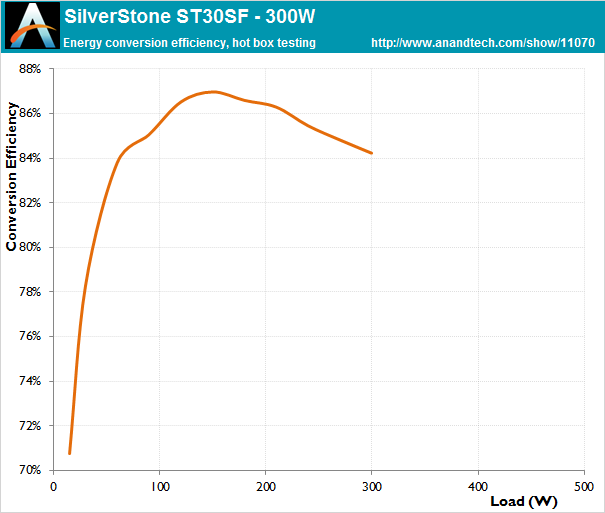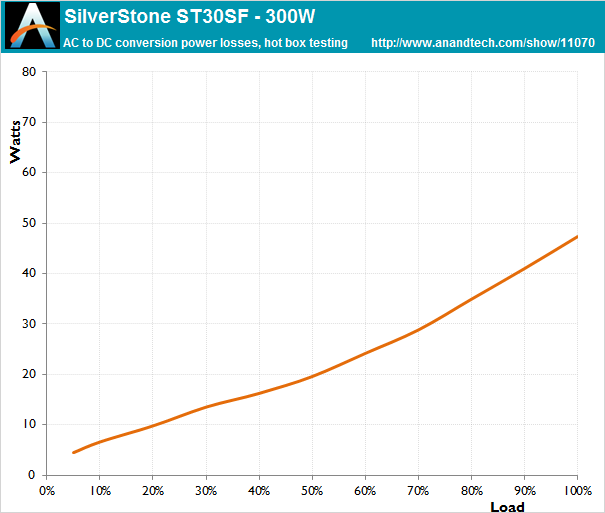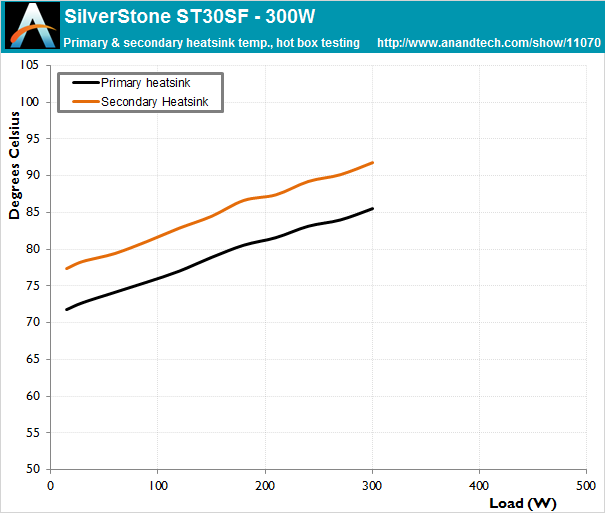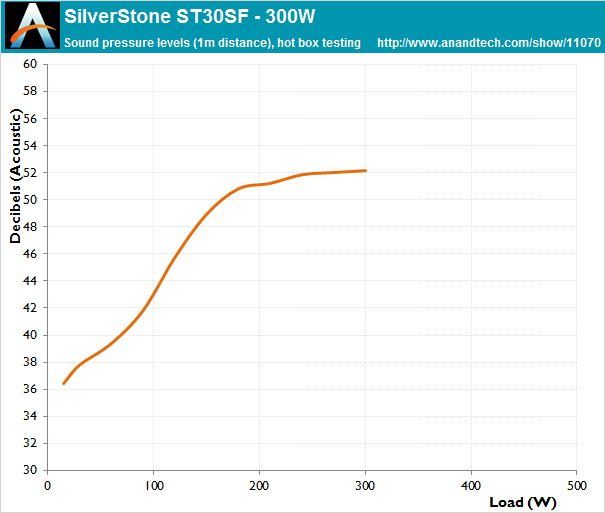The Silverstone ST30SF & ST45SF SFX Power Supply Review
by E. Fylladitakis on January 26, 2017 9:00 AM EST- Posted in
- Cases/Cooling/PSUs
- PSUs
- 80Plus Bronze
- SilverStone
- SFX
- ST30SF
- ST45SF
Hot Test Results
As we can see from their performance tables, the ST30SF and the ST45SF both display very good power quality figures for PSUs of their class. The filtering figures of the ST30SF are better, with a maximum ripple of about 42 mV on the 12V line under maximum load. The ST45SF reached up to 64 mV on the 12V line under maximum load, but that was to be expected given its much higher output. If we were to compare the two units on a per-watt basis, the ST45SF does deliver better power quality figures, which is to be expected considering its more capable electronic components. The voltage regulation of both units is almost identical, with an average of about 1.7% on the 3.3V/5V lines and 1.9% on the 12V line.
| SilverStone ST30SF Main Output | ||||||||
| Load (Watts) | 60.95 W | 151.64 W | 226.57 W | 299.92 W | ||||
| Load (Percent) | 20.32% | 50.55% | 75.52% | 99.97% | ||||
| Amperes | Volts | Amperes | Volts | Amperes | Volts | Amperes | Volts | |
| 3.3 V | 1.31 | 3.37 | 3.28 | 3.35 | 4.91 | 3.33 | 6.55 | 3.32 |
| 5 V | 1.31 | 5.1 | 3.28 | 5.08 | 4.91 | 5.05 | 6.55 | 5.03 |
| 12 V | 4.09 | 12.19 | 10.23 | 12.12 | 15.35 | 12.08 | 20.47 | 11.98 |
| Line | Regulation (20% to 100% load) |
Voltage Ripple (mV) | |||||
| 20% Load | 50% Load | 75% Load | 100% Load | CL1 12V |
CL2 3.3V + 5V |
||
| 3.3V | 1.6% | 12 | 10 | 10 | 12 | 10 | 12 |
| 5V | 1.5% | 8 | 12 | 12 | 16 | 10 | 12 |
| 12V | 1.8% | 14 | 24 | 28 | 42 | 38 | 20 |
Even though SilverStone rates the new revision models at 40 °C, they had no problem reaching their maximum power output inside our hotbox. Unexpectedly, their energy conversion efficiency dropped only very slightly as well, with the average nominal load (20-100%) efficiency dropping down to 85.6% and 85.8% for the ST30SF and the ST45SF respectively. We would expect the impact to be much higher considering their design and the very high temperatures, but both units proved us wrong.
| SilverStone ST45SF Main Output | ||||||||
| Load (Watts) | 91.65 W | 228.35 W | 338.28 W | 449.76 W | ||||
| Load (Percent) | 20.37% | 50.74% | 75.17% | 99.95% | ||||
| Amperes | Volts | Amperes | Volts | Amperes | Volts | Amperes | Volts | |
| 3.3 V | 1.69 | 3.38 | 4.22 | 3.37 | 6.33 | 3.32 | 8.44 | 3.31 |
| 5 V | 1.69 | 5.12 | 4.22 | 5.09 | 6.33 | 5.06 | 8.44 | 5.03 |
| 12 V | 6.33 | 12.21 | 15.83 | 12.17 | 23.75 | 12.01 | 31.66 | 11.99 |
| Line | Regulation (20% to 100% load) |
Voltage Ripple (mV) | |||||
| 20% Load | 50% Load | 75% Load | 100% Load | CL1 12V |
CL2 3.3V + 5V |
||
| 3.3V | 1.65% | 16 | 16 | 18 | 18 | 16 | 16 |
| 5V | 1.7% | 18 | 20 | 20 | 22 | 24 | 20 |
| 12V | 1.9% | 18 | 26 | 36 | 64 | 68 | 40 |

| Efficiency |

| Power Losses |
The low impact of the high temperature on the efficiency of the units hints that the active components of both units are significantly oversized for their design and power rating and could, in theory, sustain their power output with an ambient temperature of 50 °C. The operating temperatures however are very high, with the ST30SF reaching temperatures of nearly 92 °C under maximum load and the ST45SF a few degrees higher than that.

| Intake & Exhaust Air Temperature |

| Heatsink Temperature |
Under such operating conditions we can see that the fans of both units shoot up to their maximum speed before the units even reach 50% of their rated maximum power output. The ST45SF reached a maximum sound pressure level of about 56 dB(A), higher than the 52 dB(A) of the ST30SF, due to its more powerful fan. The more powerful fan proved to be more than a necessity, as the ST45SF can barely maintain nominal operating temperatures when heavily loaded.

| Sound Pressure Level |










30 Comments
View All Comments
hasseb64 - Thursday, January 26, 2017 - link
Bronze? Wouldent installed one for free...A5 - Thursday, January 26, 2017 - link
The difference between Bronze and Titanium at 450W 100% load is 36W (roughly $38/year if you run 100% 24/7/365).Which isn't nothing, but it isn't a huge deal down in this power range.
TurboTastic - Thursday, January 26, 2017 - link
I totally would install one for free, and $45 is close enough to free to make it an easy choice!Yes, bronze is the minimum of the 80Plus certification. But it still means that it's 80Plus, which is better than a lot of the competition at this price point.
And what do you lose? 10W on standby, or 20W during the few minutes a day when you're really pushing the little Celeron kiosk you'd put this into? You could spend $90 on a Corsair SF450 Gold unit, or $160 on a Silverstone Platinum SX700. Even if those units had zero standby power consumption (they don't, the platinum still burns like 7W on standby), that $45 difference would buy like 4 years of electricity. You could run it for more than a decade on the SX700 before breaking even.
It's the right choice for the sign-in kiosk in the lobby, or a thin Word/Excel/Outlook client in the office. It's a fine choice for a NAS, or a media server in a closet. This is the right choice for the little Facebook machine you want to build for Grandma. And I depend on reviews like this from Anandtech so I can pick quality budget components for those machines! I'd probably be looking for a 300-500W ATX form factor power supply for 80% of my builds, and a small form-factor PSU like this one in this same power range for another 15%. Only a tiny fraction are the monster workstations and servers that need big, efficient power supplies.
Thanks, Fylladitakis, for another review of a typical power supply!
DanNeely - Thursday, January 26, 2017 - link
The minimum level is just 80 Plus, Bronze is the first step up above it. That said, especially at the 300W level just 80+ Bronze is better than most of what's on the market. Especially since this appears to be a modern 12V first design, vs a lot of the other junk on the market being old split rail designs.https://en.wikipedia.org/wiki/80_Plus#Efficiency_l...
80-wattHamster - Monday, January 30, 2017 - link
80+ is a certification based solely on efficiency, and has nothing to do with output quality or durability. It's true that in today's market, the marketing pull of 80+ being what it is, that a non-rated model isn't likely to be any good. But the rating by itself is nigh-meaningless in determining if a given unit is any good.romrunning - Thursday, January 26, 2017 - link
The SG05 that I bought with the 450W SFX PSU is still going strong. I really don't hear the fan in the PSU at all. It seems to be quieter than the CPU's fan in this min-ITX case.hybrid2d4x4 - Thursday, January 26, 2017 - link
Thanks for reviewing these smaller, relatively lower-power-rated PSUs!Props for the segment on "how picking an oversized PSU can lead to inferior overall performance", though I find it odd how this never gets mentioned in the reviews of idiotically oversized PSUs that are positioned at mainstream users (600-700W). These units get panned for being only bronze efficiency, but in the power draw situations of single-GPU systems, they would be a lot more efficient in the idle/light-usage state and possibly better while gaming compared to a PSU that is only at 30% load (in the case of a 700W).
StrangerGuy - Tuesday, January 31, 2017 - link
Yeah, it's really funny and idiotic with all that "ZOMG you need a 600W+ PSU or your PC will explode" PSU memes all around....For a typical gaming single GPU PC that idles ~50W and maybe touch 300W at full load where a 600W+ PSU will run so far away from the sweet spot on the efficiency curve.phexac - Thursday, January 26, 2017 - link
I generally stay away from commenting on the actual items you guys review, but I have to wonder here...how many people actually care about power supply reviews? Seems like there are plenty of other things to review out there...galta - Thursday, January 26, 2017 - link
Maybe the do not care, but they should.